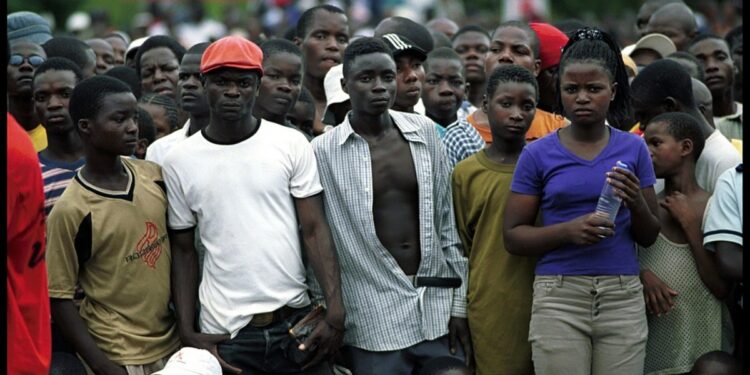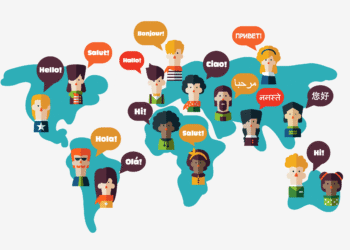Context and overview
Africa is currently facing a moment, in its history characterised by two factors; the increasing number of young people and the onset of the Fourth Industrial Revolution. With over 60% of its population under 25 years old, Africa’s youth bulge is substantial (United Nations, 2019). This youth bulge holds the potential to drive growth and progress across the continent. However, this promise is juxtaposed with challenges posed by the Fourth Industrial Revolution, which can exacerbate existing inequalities and escalate issues like youth unemployment and underemployment (World Economic Forum, 2016).
The Fourth Industrial Revolution, marked by the fusion of physical and biological technologies is reshaping economies and societies (Schwab, 2016). From intelligence and robotics to block chain and biotechnology disruptive technologies are revolutionising sectors while creating new prospects and disrupting traditional models of production and employment. Despite strides, in embracing innovation Africa still lags in harnessing the transformative power of the Fourth Industrial Revolution (World Bank, 2019).
Despite Africa’s number of people and the potential, for the Fourth Industrial Revolution to drive economic advancement, African youth encounter significant obstacles in accessing opportunities in the digital age. Widespread youth underemployment and unemployment persist throughout the continent amplified by barriers to education, skills development and job availability. Gender disparities further complicate these issues limiting women’s participation in the economy. Failing to tackle these challenges risks squandering Africa’s advantage while perpetuating cycles of poverty and inequality.
The youth bulge
In Africa, the term “youth bulge” denotes the proportion of young people within the population. This demographic trend is important for the continent’s current and future directions.
Africa’s youth bulge is characterised by its size and composition. With 60% of its populace below 25 years old Africa boasts one of the world’s youthful populations (United Nations, 2019). This demographic makeup presents both opportunities and challenges for Africa’s development.
The unprecedented scale of Africa’s youth bulge is emphasised by projections indicating that by 2050 the continent could be home, to one billion people representing a significant portion of global youth (UN, 2019).
Moreover, urban areas are experiencing a rise, in the number of people leading to challenges related to youth unemployment and underemployment as highlighted by the African Development Bank Group report in 2019.
Key factors
Birth rates
The World Bank projects that the average number of births per woman in Sub-Saharan Africa will be 4.7 in 2020 which is significantly higher than the average of 2.4. Factors contributing to this include low contraceptive usage, early marriages, limited access to family planning services and cultural preferences for larger families.
Decreasing mortality rates
Advancements in healthcare, sanitation and disease prevention have contributed to a decline in mortality rates across Africa. Notably, child mortality rates have substantially decreased over the years due to improved healthcare access, vaccinations and better nutrition for infants and children under five.
Youthful population profile
Africa is recognised by the United Nations as having a population globally with over 60% being under 25 years old. This demographic trend is a result of birth rates, reduced child mortality rates and advancements in healthcare services. While presenting opportunities for growth and social development; it also poses challenges to maintaining stability within society.
Limited access to family planning
Studies indicate that numerous African nations still face challenges in accessing methods. The World Health Organization (WHO) highlighted that the utilisation rate of contraceptives in Sub-Saharan Africa stood at 26.9% in 2020. Factors hindering access to family planning include a lack of awareness, cultural and religious beliefs, gender disparities and inadequate healthcare infrastructure.
Urbanisation & migration
Africa is experiencing urbanisation with the urban population projected to triple by 2050. One notable example is Lagos, Nigeria, which ranks among the growing cities globally. Urbanisation is being driven by factors such as migration, natural population growth and economic opportunities in urban centres. Data indicates that both internal and international migration play roles in shaping population growth and demographic shifts on the continent. Notably, rural-to-urban migration remains a trend across Africa due to prospects, political unrest, conflict situations and environmental changes driving people towards urban areas. This phenomenon leads to development, cultural diversity enhancements and dynamic shifts in labour markets. However, unregulated urbanisation may result in challenges like housing options, infrastructure deficits and limited social services availability.
Benefits & challenges
The demographic phenomenon known as the youth bulge carries implications, for both progress and social cohesion.
Having several people can be beneficial, for a country’s development as it can lead to increased productivity, creativity and economic progress. However, making the most of this advantage requires investing in education, skill building and creating job opportunities to ensure that the youth actively participate in boosting the economy.
On the side, neglecting the needs of Africa’s youth could lead to economic challenges. High youth unemployment rates and lack of access to education and economic prospects can worsen unrest, migration issues and political instability. Additionally, being excluded from employment opportunities can deepen cycles of poverty and inequality posing risks to long-term development prospects.
Youth as drivers of progress
Africa’s population presents a workforce that has the potential to drive economic growth through enhanced productivity and consumer spending. By implementing policies and investments in education, skills development and entrepreneurship support these young individuals can play roles across various sectors such, as agriculture, manufacturing, technology and services.
Furthermore, harnessing the energy of the youth demographic can foster innovation and technological advancements.
Young individuals tend to be quick to embrace technology excelling in using tools, for both social interactions and business purposes. By granting the youth access to education, digital skills and entrepreneurial opportunities Africa can foster a culture of innovation and creativity leading to the emergence of crafted solutions for both global issues.
Moreover, involving people in endeavours could help mitigate the risks associated with unemployment and underemployment such as social unrest, crime and political instability. African nations can enhance unity and stability by providing avenues for skills development, job opportunities and entrepreneurship initiatives that channel the energies and ambitions of the youth toward ventures.
Lastly, investing in the education, health and well-being of individuals can yield returns in terms of developing capital over time. A healthy educated workforce with talent is essential for growth and poverty alleviation. By prioritising investments in youth development efforts Africa can set the stage for lasting progress and prosperity.
The Fourth Industrial Revolution
The Fourth Industrial Revolution signifies the fusion of technology with biological elements that has revolutionised various sectors across the globe (Schwab 2017).
Cutting-edge technologies driving this change are artificial intelligence (AI) blockchain, the Internet of Things (IoT) robotics and 3D printing. AI empowers machines to learn from data and make decisions. Perform tasks that previously demanded intelligence. This opens up possibilities, for automation, predictive analytics and personalised services. Blockchain technology enhances the security, transparency and decentralisation of transactions across sectors such as finance and supply chain management. The Internet of Things links devices to enable data collection, analysis and communication transforming industries like agriculture, healthcare and transportation.
Africa can expedite its progress by harnessing technologies to confront challenges and unlock new opportunities without the need for extensive infrastructure investments typical of past industrial revolutions. The Fourth Industrial Revolution offers cost-efficient solutions that can be swiftly put into action. Digital innovations that are remote and decentralised have the potential to bridge existing gaps in accessing services, like healthcare, education and banking. For instance, telemedicine systems utilise technology to deliver healthcare services to underserved communities while overcoming barriers.
Numerous endeavours across Africa showcase the impact of advancements. For instance, the introduction of M-Pesa, a platform originating in Kenya has revolutionised access to banking services for millions by making them more affordable and readily available (Jack and Suri 2014). Meanwhile, Zipline’s drone delivery service in Rwanda and Ghana ensures reliable distribution of supplies to remote areas, thereby improving healthcare services and saving lives.
The African Union’s Agenda 2063 and Smart Africa initiatives aim to leverage technology for enhancing socio growth and fostering regional integration (African Union Commission, 2015). These initiatives promote collaboration among governments, businesses and civil society to encourage the adoption of solutions and cultivate innovation ecosystems throughout Africa.
Empowering Africa’s youth population
The demographic shift towards a population in Africa presents both challenges and opportunities for the continent’s advancement. To harness the potential of this burgeoning youth, during the Fourth Industrial Revolution era, concerted actions are necessary to alleviate their constraints and empower them to contribute towards prosperity and societal progress.
The outlined strategies focus on steps to leverage the potential of Africa’s population:
1. Enhancing education and skill development
- Support STEM education to equip individuals, for the era (as per UNESCO 2017).
- Expand vocational training initiatives to provide hands-on skills and job opportunities in emerging fields (referencing ILO, 2018).
- Encourage literacy programs to ensure youths feel at ease with technology. Can utilise it for learning and innovation (based on ITU, 2019).
2. Fostering entrepreneurship and innovation
- Back the development of startup communities through incubators, accelerators and initial funding for aspiring entrepreneurs (per insights from the World Bank, 2019).
- Improve access through means like venture capital, microfinance and crowdfunding platforms (in line with IFC practices in 2016).
- Implement mentorship programmes and capacity-building efforts to nurture skills and foster a culture of innovation and risk-taking (following recommendations, in 2019).
3. Addressing the digital disparity
- To narrow the divide, enhance the availability of internet access and digital infrastructure especially in rural or underserved regions (as suggested by GSMA in 2020).
- Invest in projects that improve internet access, for people by focusing on last-mile connectivity initiatives like community networks and satellite technology as recommended by ITU in 2021.
- Support policies that enhance inclusion by making digital services more affordable, accessible and relevant for marginalised groups as advocated by UNDP in 2020.
4. To address gender disparities
- Implement strategies to achieve gender equality in education and employment including efforts to remove obstacles for women and girls as suggested by UN Women in 2019.
- Offer mentorship and leadership training programmes for young women pursuing careers in STEM fields and entrepreneurship to empower them as agents of change according to WEF’s recommendations in 2021.
- Promote awareness about the significance of gender diversity and inclusion at work encouraging companies to adopt gender policies and practices following ILO’s guidelines from 2021.
5. Promote partnerships
- Foster collaboration between governments, businesses, civil society organisations and international bodies to enhance impact based on AU’s advice from 2018.
- Establish platforms involving stakeholders and innovation centers to facilitate sharing knowledge mobilising resources and taking action on programs aimed at empowering youth. This aligns with UNDP guidance, from 2018.
- Utilise the expertise and input, from all parties to create and put into action strategies to address the intricate challenges that young individuals, in Africa encounter (OECD, 2020).
Success Stories
The examples provided below illustrate how creative programmes and projects are leveraging Africa’s population to drive growth and technological advancement in the era of the Fourth Industrial Revolution.
- M-Pesa, Kenya
The introduction of M Pesa by Safaricom in 2007 revolutionized mobile. Financial inclusion in Kenya. This initiative allows individuals to transfer funds settle bills and access services using their mobile devices. By engaging Kenyans as agents and service providers M Pesa contributes to empowering the economy and reducing poverty (Jack & Suri 2014).
- Andela, Nigeria
Established in 2014 Andela is a tech startup that identifies and nurtures talent to become proficient software developers. Through training and remote work opportunities with IT firms, Andela addresses the skills gap in the technology sector while creating job prospects for African youth thereby fostering economic development and innovation.
- YouthConnekt, Rwanda
Launched in Rwanda in 2012 YouthConnekt is a platform that promotes entrepreneurship, employment, and leadership among young individuals. This initiative provides aspiring entrepreneurs, with training, guidance, and financial support to kick start and expand their businesses. YouthConnekt has effectively linked Rwandans to various opportunities, across different sectors fostering inclusive growth and societal progress.
- iHub, Kenya
iHub, which was established in 2010 serves as an innovation centre and collaborative workspace in Nairobi supporting tech companies and aspiring entrepreneurs. This hub cultivates an environment for collaboration networking and skill enhancement promoting innovation and entrepreneurial spirit in the area. iHub has played a role in nurturing Africa’s tech landscape by nurturing enterprises and backing digital innovation as a catalyst for economic change.
Way forward
Tapping into the potential of the Fourth Industrial Revolution (4IR) for Africa’s population requires an approach that leverages key frameworks such as the Internet, ECOWAS, the African Union (AU) and the African Continental Free Trade Area (AFCFTA). By expanding broadband infrastructure and promoting literacy initiatives African youth can gain access to digital tools and skills necessary to thrive in the digital economy. For instance, Kenya’s Digital Literacy Program has effectively equipped elementary school students with computer skills laying down a foundation for their future involvement in digital realms.
Engagement at levels, within ECOWAS and AU, can accelerate the growth of trade and innovation ecosystems by fostering cross-border entrepreneurship and knowledge sharing.
The implementation of the AfCFTA offers an opportunity to establish a marketplace that enables led businesses to expand their activities and access broader markets. For instance, the AfCFTA aims to boost African trade by 52% by 2022 creating new possibilities, for budding entrepreneurs throughout the continent.
Moreover establishing centers for innovation and programs that empower youth can cultivate a climate of creativity and business acumen among youth thereby promoting inclusive development and sustainability. By utilising these structures and initiatives Africa can harness the power of the Fourth Industrial Revolution to unlock the full potential of its youth and accelerate socio-economic advancement across the region.
Conclusion
Africa’s youthful population plays a role in progress and economic prosperity. Investment in education, skill enhancement and empowerment of individuals is crucial for unlocking their capabilities and fostering innovation in the era of advancement. Policymakers, businesses and civil society must prioritise initiatives tailored towards youth empowerment by nurturing entrepreneurship providing quality education and bridging disparities. Collaborative efforts aimed at developing strategies can pave the way for a future, for future generations. As we navigate through both challenges and opportunities presented by the Fourth Industrial Revolution let us commit ourselves to empowering Africa’s youth by creating an environment to their growth so they can contribute meaningfully to their societies well-being and economic progress.































